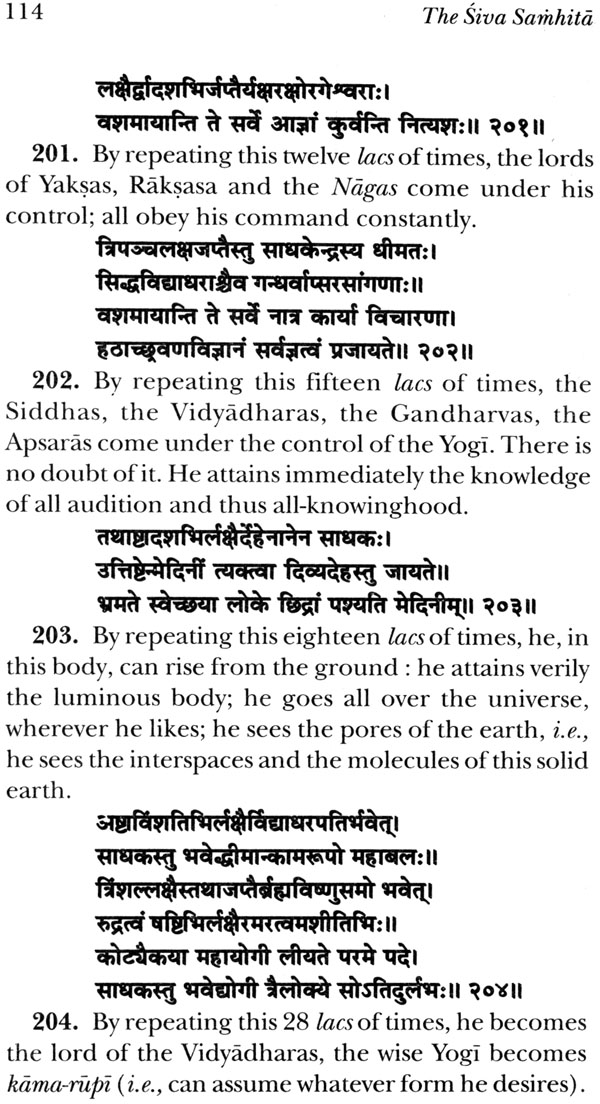
The Siva Samhita
Book Specification
| Item Code: | NAG376 |
| Author: | Srisa Chandra Vasu |
| Publisher: | Dev Publishers and Distributors |
| Language: | English |
| Edition: | 2013 |
| ISBN: | 9789381406182 |
| Pages: | 128 |
| Cover: | Paperback |
| Other Details | 8.0 inch X 5.0 inch |
| Weight | 110 gm |
Book Description
Siva's compendium, written during the eighteenth century made it appear, as if Siva himself was speaking. The work frequently alludes to the Tantras and there is a distinct Buddhist influence throughout the text. This is one of three major surviving classical treatises on the Hatha Yoga. It deals with abstract yogic philosophies, tantric practices, mudras and meditation. It emphasizes that even householders can practice yoga and benefit from it. This English translation has rare insights into this ancient text.
Siva Samhita is a Tantrika treatise on Yoga. It was translated by me as far back as 1884 and first published in the Arya of Lahore-a monthly journal conducted by the late Mr. R.C. Bary.
The mystic phraseology of the Tantras is very difficult to understand. My brother, Major B.D. Basu, I.M.S., the Editor of the Series of these Sacred Books of the Hindus, said in his Prize Essay on the Hindu System of Medicine published in the Guy's Hospital Gazette of London (1889), regarding the anatomy of the Tantras:
'When these Tantras will be studied by oriental scholars, as closely as they have explored other branches of Sanskrit learning, the anatomical knowledge of the ancient Hindus shall be better known to the world;" for, according to him, "better anatomy is given in the Tantras than in the medical works of the Hindus."
"From Siva Samhita we learn that the Hindus were acquainted with the spinal-cord and the brain. They knew that the central nervou sy t m i ompos dof grey and white matters. They discovered the central canal of the spinal-cord, and traced its connexion, through the fourth and third ventricles, with the lateral ventricles of the brain. They call it Brahmarandhra or the dwelling-house of the human soul.
The same Tantric work gives a description of the several ganglia and plexuses of the nervous system. The brain is said to be composed of Candrakala or convolutions resembling half-moons."
In a paper on the Anatomy of the Tantras, originally published in the "Theosophist" for March 1888, Major Basu has tried to unravel the mystery of the Yogis and Tantrists regarding the nerves and nerve-centres, and identify the Niidis, Cakras, and Padmas. The following is a reproduction from that paper:-
"The language of the Tantras being too allegorical and too mystical to be understood by the uninitiated, it is very difficult to identify the Nadis, the Cakras, and the Padmas described in them.
"However, some of the spots are easily identifiable from their simple and lucid description. Thus, it is apparent that the "nectar-rayed moon" (vide Siva Samhita, Ch. II, verse, (6) is the underpart of the brain; that "Susumna" is the spinal cord; "Ida" and "Pingala" are the left and right sympathetic cords respectively. "
We shall try now to identify some of the nervous structures described in the Tantras:-
"Citra"-From the description of this Nadi in the Tantras (Siva Samhita, Ch. II, verses 18-19), it may be identified with the grey matter of the spinal cord. For "in it is the subtlest" of all hollows called 'Brahma- randhra,' which is nothing else save the central canal of the spinal cord-a structure whose functions remain as yet to be discovered by the physiologists. The Tantrists appear to have traced its connection with the lateral ventricles of the brain. It has been considered by them to be the seat of the human soul. Even in these days, when it is no exaggeration to say that the Hindus have quite forgotten the scientific truths discovered by their ancestors, they point to the hollow space in the crown of the head (known as the anterior fontanalle) of the new-born child as the Brahmarandhra.
Every tyro in anatomy knows that this space contains the lateral ventricles of the brain.
The "Sacred Triveni" (Siva Samhita, Ch. V, p. 69) is the spot in the medulla oblongata where the sympathetic cords join together or whence they take their origin. (Vide Ashby's Notes on Physiology, -Article Medulla Oblongata). The mystic Mount Kailasa (Siva Samhita, Ch. V, p. 72) is certainly the brain.
| Foreword | vii |
| Chapter 1 | 1 |
| Chapter 2 | 20 |
| Chapter 3 | 31 |
| Chapter 4 | 54 |
| Chapter 5 | 69 |













